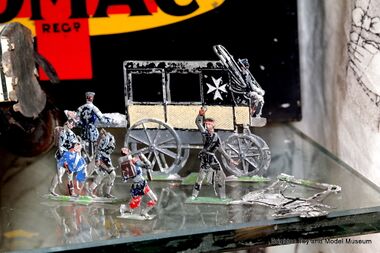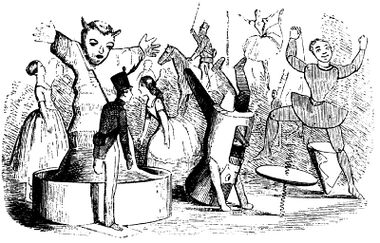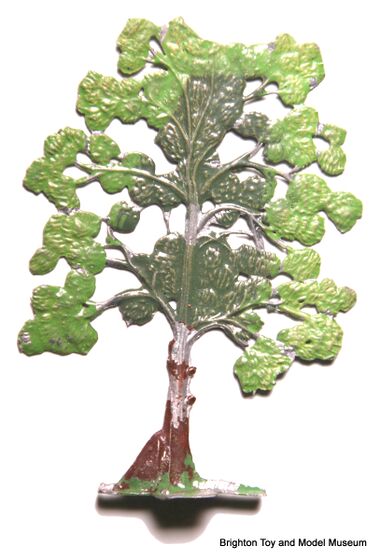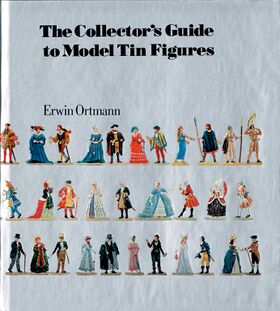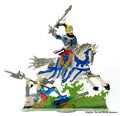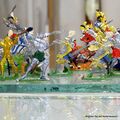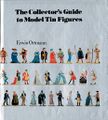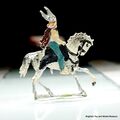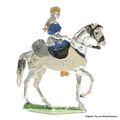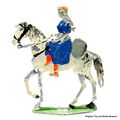Category:Flat lead figures
St John's Ambulance lead figure "flats" [image info]
1850: Illustration by Vilhelm Pedersen, for Hans Christian Andersen's 1838 story "The Steadfast Tin Soldier" (MediaWiki) [image info]
Painted flat lead tree, Germany [image info]
1974: The Collector's Guide to Model Tin Figures, by Erwin Ortmann [image info]
The first commercial cast lead and lead-alloy figures were almost two-dimensional "flats" or "flatties" (Zinnfiguren), mostly made in Germany in the Nineteenth and early Twentieth Century. The main manufacturer was Heinrichsen of Nuremburg, who specialised in military sets of historic battles.
Manufacture
The manufacture of "flats" involves an unusual combination of two-dimensional design and three-dimensional sculpture. The design is first produced as a pair of drawings in 2D by a draughtsman and transferred (front and back) to a pair of slate slabs, after which a sculptor carves the shapes, shallowly, into the slate (the "stone") to produce the mould.
"Nuremberg scale"
Heinrichsen established a default scale for the genre of "28mm from base to to eye level", which became known as "Nuremburg scale", or just "28mm".
Terminology
Technically, "zinn" means "tin", and "Zinnfiguren" means "Tin figures", but the term was used as a generic term in Germany to include pewter and lead figures, which sometimes led to confusion when legislation affected supplies of tin.
In Britain, flat lead figures are not the norm, and are often known as flatties or or lead flats to distinguish them from "normal" solid or hollowcast three-dimensional lead figures. In Germany where there was more of a tradition of 2D lead/pewter/tin figures, they are just known as "zinnfiguren", and there's instead special naming for the three dimensional cast figures.
Advantages of two dimensions
The largely two-dimensional design process of "flatties" was almost foolproof - a skilled draughtsman could produce a huge number of designs in a comparatively short time that could then be assigned to a carver or set of carvers for implementation. By contrast, three-dimensional figures couldn't be fully designed on paper, and the designer pretty much had to carry out the whole process themselves without being able to delegate. Three-dimensional design also involved overcoming issues of whether a shape could be successfully extracted form the mould after casting, whether the mould had to be made from separate parts to accommodate complex shapes, how long the thicker 3D figures would need to fully solidify, and so on.
Flat figures were also easier to paint, which encouraged more extravagant and elaborate painting schemes.
- In the UK, "hollowcasting" alleviated the problem of the higher metal cost and longer cooling times of solid 3D figures, and the output of W. Britain Ltd. and other manufacturers largely replaced "flatties", with the exception of trees and shrubbery, which tended to stay flat as the complex shapes were difficult to mould in three dimensions (and tended to be background decoration).
- For the Britains Gardening range, W. Britain came up with a hybrid system: they supplied their plants and flowers cast and painted "splayed flat", but the user would then bend the soft metal stems into more natural and organic shapes.
- In Germany, affection for the tradition and artistry of "flatties" mean that the genre still survives, with users typically buying the figures bare and painting them themselves. Larger Zinnfiguren scenes with flat figures cast into a flat ornate frame also work as hanging or window decorations, and the format also remains a traditional Christmas decoration.
Verband deutscher Zinnfigurenfabrikanten
The "Association of German Pewter Manufacturers" "Verband deutscher Zinnfigurenfabrikanten" ran from 1905 to 1935, its membership representing practically every significant German manufacturer (a previous association specific to Fürth, "Verband Fürther Zinnfiguren-Fabrikanten" (1900-1906), became redundant after the formation of the new association, and wound itself up).
"Deutsche und internationale Zinnfigurenbörse Kulmbach
The German and International Pewter Figure-Maker's Fair is held every two years in Kulmbach, Germany. The Fairs started being held in 1937.
In popular culture: Hans Christian Andersen
Hans Christian Andersen's 1838 story, "The Steadfast Tin Soldier" ("Den standhaftige tinsoldat") is supposed to be the author's first published story not to be based on an existing fairy tale or folk story. The "Tin Soldier" character seems to be a lead flat, as shown by the 1850 illustration by Vilhelm Pedersen, and also by the plot details: a set of twenty-five soldiers are cast from a single spoon, and the soldier is able to be floated down a gutter in a paper boat, and melts easily in a fire.
In the museum
The museum has a collection of about two hundred and fifty lead flats in Arch Four on display on four well-lit glass shelves (around two hundred military, and around fifty animals and other non-military pieces), a small handful in the "Joy of Little People" display in Arch Two, and another small group in the "Ambulances" display cabinet, also in Arch Two.
Books
- Erwin Ortmann, The Collector's Guide to Model Tin Figures (Studio Vista, 1974) ISBN 0289703409
External links
- International Flat Figure Society - British Flat Figure Society (intflatfigures.org)
- Enthusiast's site (flats-zinnfiguren.com)
- Verband deutscher Zinnfigurenfabrikanten (zinnfiguren-bleifiguren.com)
- Wilhelm-Schweizer pewter figurines - over 200 years of family tradition (zinnfiguren.de)
- Berliner Zinnfiguren - Flat Figures (zinnfigur.com)
- Zinnfigur (de.wikipedia.org)
museums and exhibitions:
Subcategories
This category has the following 5 subcategories, out of 5 total.
Pages in category ‘Flat lead figures’
The following 3 pages are in this category, out of 3 total.
Media in category ‘Flat lead figures’
The following 13 files are in this category, out of 13 total.
- Battle of Morat, lead figures set - Zinnfiguren (Heinrichsen of Nuremburg).jpg 2,284 × 3,000; 2.13 MB
- Melee, Battle of Morat, flat lead figures (Heinrichsen of Nuremberg).jpg 3,000 × 3,000; 3.9 MB
- St Johns Ambulance wagon and figures, lead flats (possibly C19th).jpg 2,000 × 1,334; 1.63 MB
- Tree, lead flat 01.jpg 814 × 1,200; 454 KB
- Tree, lead flat 02.jpg 642 × 1,200; 304 KB
- Viking on Horseback, lead flat (possibly Henrichsen).jpg 3,000 × 3,000; 2.1 MB
- Viking Raid, flat lead figures - zinnfiguren (possibly Heinrichsen).jpg 2,451 × 3,000; 2.16 MB
- Vilhelm Pedersen, Tin Soldier (MediaWiki).jpg 800 × 512; 289 KB
- Woman on Horseback, back, flat lead figure (possibly Heinrichsen).jpg 3,000 × 3,000; 1.4 MB
- Woman on Horseback, front, flat lead figure (possibly Heinrichsen).jpg 2,995 × 3,000; 1.72 MB
- Zoo animals, flat lead figures - zinnfiguren.jpg 1,600 × 662; 406 KB
